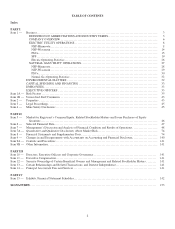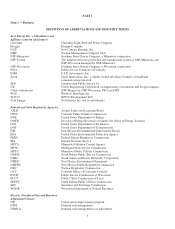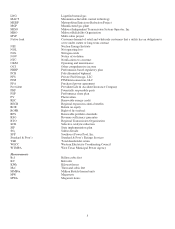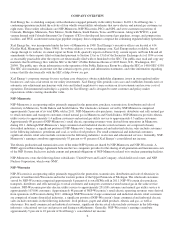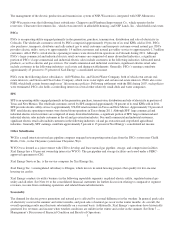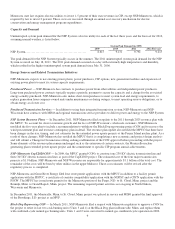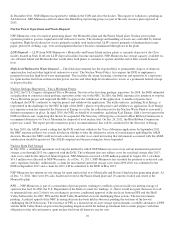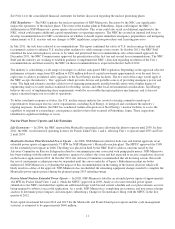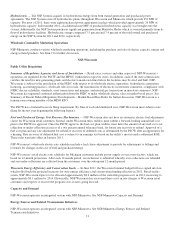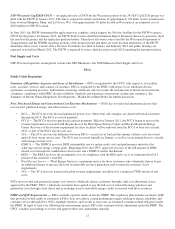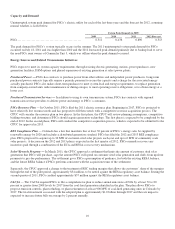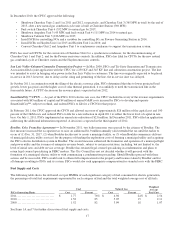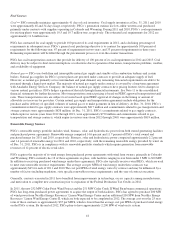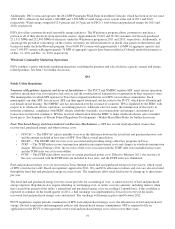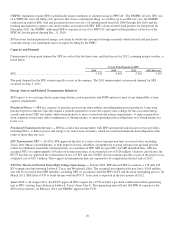Xcel Energy 2011 Annual Report Download - page 22
Download and view the complete annual report
Please find page 22 of the 2011 Xcel Energy annual report below. You can navigate through the pages in the report by either clicking on the pages listed below, or by using the keyword search tool below to find specific information within the annual report.
12
Fuel Supply and Costs
The following table shows the delivered cost per MMBtu of each significant category of fuel consumed for electric generation,
the percentage of total fuel requirements represented by each category of fuel and the total weighted average cost of all fuels.
Coal* Nuclear
Natural Gas
NSP System Generating Plants
Cost Percent Cost Percent Cost Percent
Weighted
Average
Fuel Cost
2011
.....................
$
2.06 55% $
0.89 40% $ 6.56
5
% $ 1.82
2010
.....................
1.89 51 0.83 42 6.29
7
1.73
2009
.....................
1.78 57 0.70 39 7.36
4
1.61
* Includes refuse-derived fuel and wood.
See Items 1A and 7 for further discussion of fuel supply and costs.
Fuel Sources
Coal — The NSP System normally maintains approximately 40 days of coal inventory. Coal supply inventories at Dec. 31, 2011
and 2010 were approximately 48 and 39 days usage, respectively. NSP-Minnesota’s generation stations use low-sulfur western
coal purchased primarily under contracts with suppliers operating in Wyoming and Montana. During 2011 and 2010, coal
requirements for the NSP System’s major coal-fired generating plants were approximately 9.5 million tons. The estimated coal
requirements for 2012 are approximately 8 million tons, including adjustments to account for Sherco Unit 3, which was shut
down in November 2011 after experiencing a significant failure of its turbine, generator, and exciter systems. It is uncertain when
Sherco Unit 3 will recommence operations.
NSP-Minnesota and NSP-Wisconsin have contracted for coal supplies to provide 99 percent of their coal requirements in 2012,
and a declining percentage of the requirements in subsequent years. The NSP System’s general coal purchasing objective is to
contract for approximately 100 percent of requirements for the following year, 67 percent of requirements in two years, and 33
percent of requirements in three years. Remaining requirements will be filled through the procurement process or over-the-
counter transactions.
NSP-Minnesota and NSP-Wisconsin have a number of coal transportation contracts that provide for delivery of 100 percent of
their coal requirements in 2012 and 2013. Coal delivery may be subject to short-term interruptions or reductions due to operation
of the mines, transportation problems, weather and availability of equipment.
Nuclear — To operate NSP-Minnesota’s nuclear generating plants, NSP-Minnesota secures contracts for uranium concentrates,
uranium conversion, uranium enrichment and fuel fabrication. The contract strategy involves a portfolio of spot purchases and
medium and long-term contracts for uranium concentrates, conversion services and enrichment services with multiple producers
and with a focus on diversification to minimize potential impacts caused by supply interruptions due to geographical and world
political issues.
• Current nuclear fuel supply contracts cover 100 percent of uranium concentrates requirements through 2017 and
approximately 66 percent of the requirements for 2018 through 2025.
• Current contracts for conversion services cover 100 percent of the requirements through 2017 and approximately 78
percent of the requirements for 2018 through 2025.
• Current enrichment service contracts cover 100 percent of the requirements through 2016 and approximately 95 percent
of the requirements for 2017 through 2025.
Fabrication services for Monticello and Prairie Island are 100 percent committed through 2025 and 2014, respectively. A contract
for fuel fabrication services for Prairie Island is currently being negotiated for 2015 and beyond.
NSP-Minnesota expects sufficient uranium concentrates, conversion services and enrichment services to be available for the total
fuel requirements of its nuclear generating plants. Some exposure to spot market price volatility will remain due to index-based
pricing structures contained in some of the supply contracts.


